Reducing deadline bunching
This guidance outlines the detrimental impact of assessment bunching on students and offers suggestions on how this can be managed in programmes.
Why is assessment bunching bad?
Assessment bunching refers to instances where multiple assessment deadlines are set for students over a relatively short period. This can pose several risks, including:
- Increased stress and anxiety: Managing multiple deadlines at the same time can lead to increased stress and anxiety. It can feel overwhelming and create a sense of pressure to complete multiple tasks within a limited timeframe. This can negatively affect mental well-being and academic performance.
- Reduced quality of work: When students are faced with multiple deadlines, they may have insufficient time to dedicate to each task, resulting in performance that does not reflect their potential. Rushing assignments or studying hastily is likely to reduce the quality, diminish learning and resulting in lower grades.
- Time management challenges: Bunching deadlines can make it difficult prioritize tasks, allocate time appropriately and keep a balanced schedule. This may result in missed deadlines or unfinished work. General time management skills may suffer in the long run.
- Negative impact on physical health: The stress and pressure of managing multiple deadlines can have negative effects on physical health. Working long hours to meet deadlines can result in lack of sleep, poor nutrition and reduced opportunities for physical exercise. this could result in fatigue, weakened immunity other health issues that can further affect academic performance and overall well-being.
- Limited opportunities for revision or feedback: Bunching of deadlines may result in limited opportunities for revision or feedback from instructors. When students have multiple assignments due simultaneously, they may not have enough time to revise their work or seek feedback from instructors, which can result in missed learning opportunities and reduced opportunities for improvement.
- Impaired work-life balance: Bunching deadlines can also disrupt students' work-life balance. They may sacrifice their social and domestic lives, extracurricular activities or personal time. Poor work-life balance can result in physical and mental health issues, stress and unhappiness.
- Increased likelihood of academic misconduct: People can act uncharacteristically of they are under pressure. Students may be tempted to cheat. For instance, they may rely on AI (Artificial Intelligence) text construction software to write all or sections of their work rather than fully engaging in the reading and development of their own ideas.
- Impact on other academic and professional service teams: Many other individuals and teams work with students to support their assessments. Spreading deadlines eases the pressure on the teams. It also provides students with more opportunities to engage with them and get the support they need.
- Spreading marking burden: Although making significant changes to course and assessment design can take time, the end outcome would spread the marking and feedback load across the programme team and possibly improve your workload at particular times of the year.
Practical steps to reduce bunching
There are several approaches that can be taken to reduce assessment deadline bunching for university students. These include:
- Communication and coordination among tutors: Encouraging communication and coordination across a team can help spread out deadlines more evenly. It helps team members to be mindful of the workload facing students. By working together, teams can help reduce bunching of deadlines and create a more balanced workload.
- Planning and scheduling at programme level: teams can proactively plan and schedule assessments throughout the semester to avoid bunching deadlines. This can involve creating a timeline for assessments at the beginning of the semester, taking into consideration the workload of students and ensuring that assessments are distributed evenly over time.
- Flexibility in assessment deadlines: Providing flexibility in assessment deadlines can be beneficial in reducing bunching. Teams can consider allowing students to submit assessments in a wider assessment window, rather than on a single date. This can provide students with more flexibility in managing their workload and allow them to better prioritize their tasks.
- Early feedback and formative assessments: Implementing early feedback and formative assessments can also help reduce the impact of bunched deadlines. Providing opportunities for students to receive feedback and engage in formative assessments throughout the semester will help students to stay on track and avoid last-minute cramming. This can also promote a more even distribution of workload across the semester.
- Time management and study skills training: Providing students with training and resources on time management and study skills can help them better manage their workload. Workshops, tutorials or online resources that provide guidance on effective time management, study techniques and prioritisation techniques can be helpful. This can empower students with skills to plan ahead, stay organized, and manage their assessments more effectively.
Different approaches to delivery
Deadline bunching is most likely to occur when module end in the same time period. This is based on the simple premise that some assessment will occur after teaching has finished. Changing delivery patterns within a semester is a straightforward solution and will require no changes to the validated programme.
Most programmes offer modules in a semester that are delivered in parallel, as illustrated below.
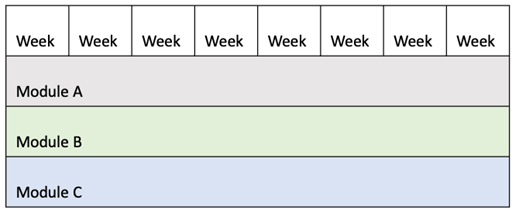
Fig 1. Three modules run in parallel across weeks.
Changing just two modules: Here is the same programme with an amended modules delivery. Module (A) finishes earlier because there was more teaching in the first weeks. B starts later, with more teaching at the end of the period. C runs across the semester.
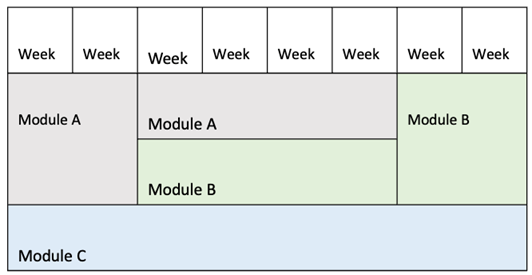
Fig 2. Two modules swapping delivery periods to end at different points in the semester. Module (A) finishes earlier, Module (B) starts later allowing (A) to use more teaching time at the start, leaving (B) more teaching time at the end.
Introductory module: A single module could be blocked taught at the beginning of the semester to support the student induction as well as reducing assessment bunching.
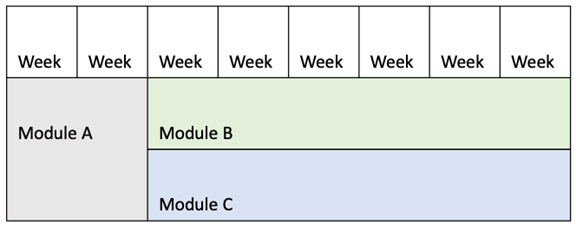
Fig 3. A single module (A) taught in the first weeks with other modules taught in parallel after (A) is finished.
Capstone module: A single module could be block taught at the end of the semester to support the bringing together of subject knowledge from the previous modules as well as reducing assessment bunching.
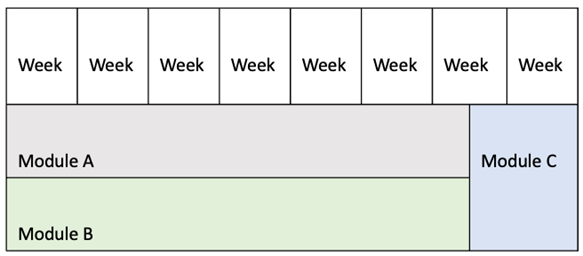
Fig 4. A single module (C) taught in the last weeks with other modules taught in parallel and both finishing earlier.
Block delivery: Modules are taught sequentially in blocks.
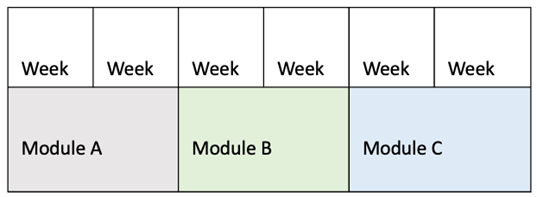
Fig 5. All modules are taught sequentially. Each is finished being taught before the next begins.
Recommendations
- Discuss ideas with your team
- Focus on levels 3 and 4, and first semester. This may have the biggest impact on the student experience and help build confidence and resilience.
- Monitor student reactions through open discussion.
- If you are considering block teaching, consider reviewing teaching approaches as opportunity to introduce more active learning.
None of these changes require registry approval, but please share your practice with others to help build understanding.
